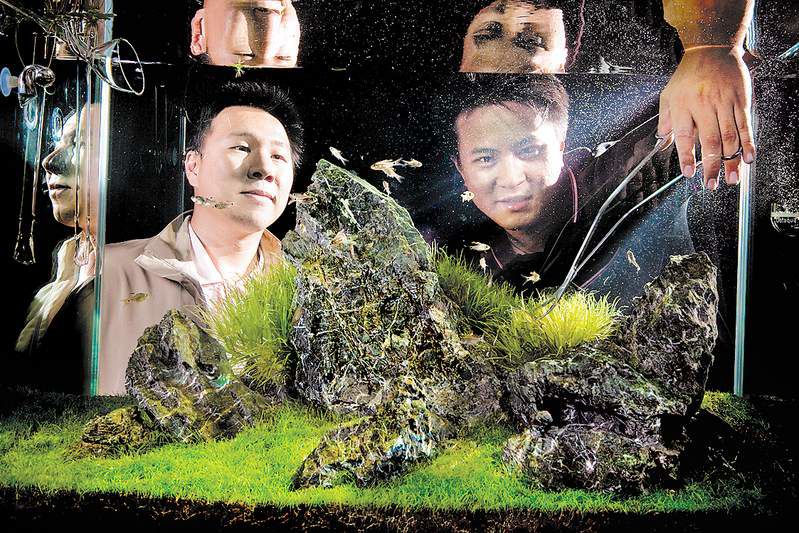Water worlds
Published 5:00 am Sunday, September 27, 2009

- Steven and George Lo created Aqua Forest Aquarium in San Francisco, the first shop in the United States to specialize in the style known as “nature aquarium,” which was developed in the late 1970s by Japanese nature photographer Takashi Amano, whom George Lo describes as “like a god.”
SAN FRANCISCO — In the display tanks of Aqua Forest Aquarium, there is no neon gravel, no miniature plastic castles, no sunken treasure boxes sprinkled with glitter. Instead, owners and brothers George and Steven Lo have created natural replicas of miniature underwater worlds: a branched piece of driftwood draped with dark green moss, a lush undulating fern-filled forest, a peaceful grassy meadow and, in a tiny 5 1/2-gallon tank, a jewel box water-filled terrarium. Small fish and shrimp dot these environments, but like a flock of birds or grazing cattle in a landscape painting, they are only supporting characters. Here, the underwater plants get the attention.
Aqua Forest Aquarium is the first shop in the United States to specialize in the style known as “nature aquarium” — the idea that rather than simply housing a colorful collection of fish, an aquarium should reflect the beauty, visual harmony and even tension of a wild landscape. Plants are the main element, but driftwood and stones are used as well to create a more natural feel. There are other types of planted aquariums, but this design philosophy was developed in the late ’70s by Japanese nature photographer Takashi Amano, whom George Lo describes as “like a god.”
Nature aquariums are more popular in Asia, but the trend is taking root in the U.S. The movement owes its existence to Amano, who has put out four lavish books about freshwater aquascaping. He began experimenting with aquariums in his early 20s, inspired by a boyhood playing in the Yoroi wetlands in Japan and later during trips to tropical rain forests in the Amazon, West Africa and Borneo.
“When I swam in the river, I found many aquatic plants flourishing and fish swimming in schools,” he wrote in an e-mail. “Here the plants are the place for spawning, and hiding place for fish.” Underwater, he found a world where plants turned sunlight into oxygen for fish, where nature found balance. “I wanted to create a space where plants and fish coexist in a harmony inside an aquarium tank.”
Amano’s aquascapes are so dynamic and full of movement they look as if they are going to burst out of the tank. Sometimes they do. It is not uncommon for his plants, stones and driftwood to pop right out of the top by design.
“Based on my experiences, and exploration to tropical regions, I believe my layout is getting close to the image of nature and natural habitat,” Amano said. “In a sense, the layout looks more natural than nature, I think.”
Last year George Lo placed 20th in an international competition sponsored by Amano’s aquascaping company, ADA. No fewer than 1,342 people from 51 countries submitted photographs of their aquascapes.
For some, the home aquarium may conjure images of children trying out their pet-raising training wheels or a bored bachelor over-investing in tropical fish, but the planted aquarium has been gaining a U.S. following. Karen Randall, who sits on the board of the Aquatic Gardener’s Association, began getting serious about growing plants in her aquariums in the mid-1980s but had trouble back then finding a store that sold a variety of live plants. Even if an aquarium owner could find underwater plants, Randall said, information on how to take care of them was limited.
The rise of the Internet, however, has changed all that. Finding fellow underwater plant enthusiasts and sharing advice became much easier, even on an international level.
“Europe was kind of ahead of the U.S. in terms of plant selection and how to best keep them alive,” Randall said.
By 1991, the Aquatic Gardeners Association put out a magazine for 300 aquascapers, who met mostly through online message boards. Since then the number of subscriptions to the quarterly publication has quadrupled to a current high of 1,200. At their last bi-annual conference in Atlanta, 150 aquascapers attended lectures on tissue grafting and watched an “iron man aquascaping challenge” in which two people were each given one tank and one hour to aquascape it.
Amano’s books have been translated into six languages, and he lectures and holds workshops throughout the world. His company creates and sells high-end aquascaping tools, making him the authority not only on how these underwater gardens are designed, but also on how they’re tended (with near-surgical precision).






